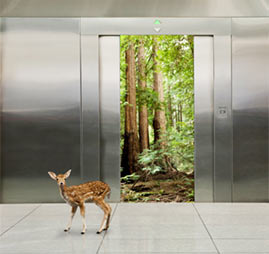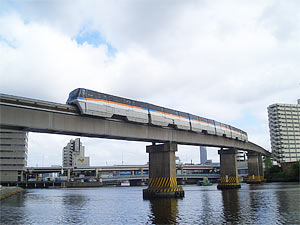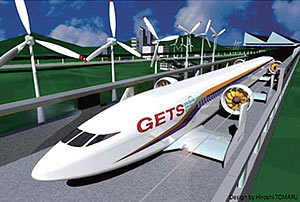Another look at transport
 Recently, the topic of road infrastructure design has been raised. I would like to catch a glimpse into the future and highlight this problem a little differently.
Recently, the topic of road infrastructure design has been raised. I would like to catch a glimpse into the future and highlight this problem a little differently.Several years ago, the main task was to automate the behavior of three cranes, which moved along one rail and performed a series of operations. Of course, the automatic machine had to plan and optimize the movements of the cranes themselves and their working devices so that they would not collide, and at the same time increase the efficiency of work.
When everything worked, it turned out an interesting thing. In the automatic control mode, the cranes began to behave in such a way that even I myself, the developer of the algorithm, could not always tell why a certain decision was made at one time or another. But, at the same time, the overall productivity of work has grown, and has grown significantly.
')
The task of simultaneously moving masses of people is a computational task, an optimization task that should not be done by a person, but by a computer.
 This is like elevator control: there are a number of buttons (queries) pressed, the current position of the cabs and the need to serve everyone in the most optimal way. While we digress from the roads and look at the task from the point of view of the elevator.
This is like elevator control: there are a number of buttons (queries) pressed, the current position of the cabs and the need to serve everyone in the most optimal way. While we digress from the roads and look at the task from the point of view of the elevator.After all, it would be great: I came up, pressed the call button, entered the cockpit - and drove to the destination point.
We’ll change the scheme a little: we’ll make the destination point selection console not in the cab, but at the waiting point. This will allow you to count a lot of things in advance. For example. The movement of the cabin can be calculated taking into account the possibility to pick up the maximum number of fellow travelers, slightly deviating from the route. If the network section is too busy, cab movement can be automatically redirected to parallel routes. Road sections can be marked repaired, making repairs in real time and returning them to the system.
In general, the idea is quite obvious: automatic control of traffic flows is much more efficient.
The second. Now carried out large-scale studies on the creation of auto pilots in the car. All this is of course good, but the car has to be equipped with a huge number of sensors, to apply the most serious recognition algorithms - in general, the solution of the problem is not only difficult, but also expensive. As a result, and so affordable 10% of the population of our country, the car becomes even more expensive.
The “cheap” solution of the autopilot problem is to place vehicles in the most controlled conditions.
 For example, monorail transport is immeasurably easier and cheaper to manage. Huge quantities of sensors on each “cabin” are not required, there is no danger of a pedestrian crossing, there is no “red light”. Stable environment, minimum sensors, minimum costs, and all this with very serious potentials in the speed of movement.
For example, monorail transport is immeasurably easier and cheaper to manage. Huge quantities of sensors on each “cabin” are not required, there is no danger of a pedestrian crossing, there is no “red light”. Stable environment, minimum sensors, minimum costs, and all this with very serious potentials in the speed of movement.Expensive asphalt, requiring constant seasonal renewal, can be replaced with a relatively cheap plastic box and, for example, a monorail (there are options, there is something to explore - an example only for simplicity and clarity). Branches can be combined into a single transport system with centralized management. Receiving a request from a passenger at the waiting point, the transport system selects the optimal size of the cabin (including fellow travelers) and sends it to the passenger.
The passenger has the opportunity to “order” the transport in advance, being at home or at the workplace, while the transport system in advance reports the estimated time of arrival of the vehicle at the point of departure. The transfer from point A to point B ceases to be dangerous, ceases to depend on a drunk driver on an opposite.
Additional optimization can be distinguished areas with stops from the total flow. At the same time, the speed of the main stream will be maximum, and the cab stop will not disturb others.

Of course, a number of optimizations are required. Of course, careful selection of materials is required. Of course, comprehensive debugging and the solution of a million problems are required - it cannot be otherwise in life. All this is achievable, if we have a dream, there is a specific goal - to make the movement fast, safe, worthy of the XXI century, in which we all live.
By the way, abroad it is also understood. And at this very time, a number of projects of automatic transport, including monorail, are being worked out. The leaders of Western countries are well aware: the cost of developing transport now will pay off in the future with health, safety and clean nature.


PS Two thirds of our territory is permafrost. Road transport in these cases is a rather expensive and unsafe pleasure. The creation of such a controlled system of high-speed movements, independent of weather conditions, is in fact a vital question, especially for us.
PPS The comments asked for an example of transport without a monorail. Among others, there is such a Japanese prototype of transport with a fairly cheap infrastructure and a speed of several hundred km / h:
Source: https://habr.com/ru/post/120742/
All Articles